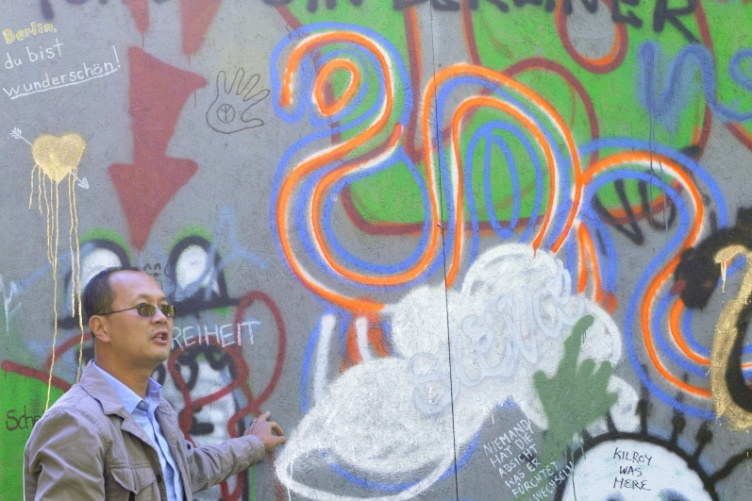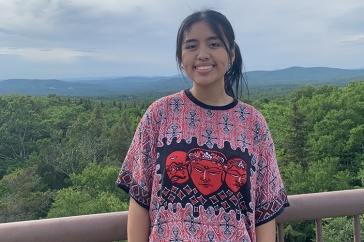
Benjamin Cariens, who teaches sculpture and other art courses at UNH, speaks to a crowd of students and faculty at the replica Berlin Wall unveiling in Murkland Courtyard on Oct. 9.
When students and faculty congregate in the popular hangout spot of Murkland Courtyard during the next few weeks, they'll be able to get a glimpse of an iconic structure in world history, and learn a bit about its symbolism and importance.
A replica of the Berlin Wall was installed recently in the open space between Murkland and Thompson Halls, thanks to the work of a team of students and staff led by sculpture professor Benjamin Cariens. It's part of the university's commemoration of the 25th anniversary of the fall of the Berlin Wall, taking place now through early November.
The UNH German program, with the financial support of the German Embassy, is revisiting the events of 1989 to take stock of the major developments of the past quarter century and also to instruct those too young to remember the impact of this historic change not only for Germany, but for the rest of Europe and beyond.
"The fall of the Berlin Wall was a pivotal moment in world history, notable not only for the peaceful nature of the revolution but also because it ushered in changes that are still in play today in our political, economic, social and cultural institutions," says German professor Mary Rhiel.
Rhiel will be one of the faculty members speaking on Tuesday, Oct. 21, about her experiences related to the wall, along with fellow faculty members from the German, political science and history departments. Rhiel spent a summer studying in Germany in 1979, and she says the panel represents people with stories of the wall from different stages of their life, which will make it an interesting cross-representation of experiences. During her own summer there, she visited with one of her classmates and her family in East Berlin—an experience she recalls as intense.
"Even though they clearly were curious about me and wanted to be good hosts to me, they were also nervous, because they had to report me to the head of their building, and tell what my exact dates of visitation were," she says. "I would say being with them was a combination of strange and familiar. I was enjoying being with a family, but it was also in the context of this surveillance society."
German professor Johannes Frank, one the panelists slated to speak next week, lived in Berlin from 1971 to 2005, working and raising his family there. He'll speak about this idea of acceptance of something abnormal, like a wall put up to divide a city.
"There's this interesting phenomenon where you get used to a very absurd situation ... it becomes normal, you don't think of it as a crazy thing anymore," he says.
He'll also talk about the euphoria Germans felt when the wall was finally opened up. When he and his friends went out in the streets on Nov. 9, 1989, it was a huge celebratory scene.
"We just decided spontaneously to have a party with friends, and the streets in East Berlin were just full of masses of people," he recalls. "We went out and invited strangers to our party. I'm not so outgoing that I would do that otherwise, but this moment really captured me; that's how it was then."
Frank was on hand for the UNH replica Berlin Wall unveiling outside the library, where a crowd of students and faculty gathered to watch, and write their own graffiti on the public art installation. He told stories of living in Germany, and traveling from West Berlin to East Berlin, and all of the security searches that entailed.
History professor Jeffry Diefendorf remembers the strict regulations between the east and west sides of the wall, as well. In the late 1970s, a cultural attaché from the East German government was invited to give at talk at UNH, and the East Germans were so pleased that they invited UNH to send someone to attend a six-week program on German language in the East German city of Weimar.
He very much enjoyed his time there, but several years later, when he returned to Germany in the early 1980s, he was stopped at one of the Berlin Wall checkpoint gates while attempting to go on a routine visit with a friend.
"After waiting for my friend for about 15 or 20 minutes, I was suddenly turned over to an East German border policeman who marched me to a room and I was strip searched," recalls Diefendorf. "Finally he said 'OK' and I got dressed and they let me go in with my day's visa."
He learned from his friend that during his six-week seminar, fellow teachers had reported him to the Stasi, the secret police, as being a CIA provocateur — which of course, he wasn't.
So being back in Germany when the wall came down in 1989 was quite a contrast: Crossing back and forth between East and West Berlin, he says, "there was no search, nothing. Just going in. The East German guards didn't even stop our car, just let us drive right through; it was so dramatically different."
UNH Fall of the Wall events earlier this month included an opening lecture by professor emerita Nancy Lukens, two film screenings (Nicolaikirche and Goodbye, Lenin!) in the MUB, and the Berlin Wall replica unveiling in Murkland Courtyard. The celebration continues into November, concluding with students submitting essays about the fall of the wall (winners will be announced on Nov. 24).
Sculptor Cariens said he was happy with the way his wall turned out, and excited to be part of the celebration.
"I jump at any opportunity to bring the art department into dialogue directly with any other program; I love the interdisciplinary quality of this event," he says.
He says creating the Berlin Wall replica was an interesting project because it differs from his other projects, both on campus and his personal work. "A lot of very substantial art doesn't start off as art; it starts off having some other function. As a sculptor, one of the things that excites me is when we have something we understand as an abstract concept that we can give some physical presence, some physical reality. But something like the Berlin Wall almost worked in reverse. It started with this physical presence that was simply meant as a division but then that started to become conceptually, culturally a symbol of divisions — division of ideologies, division of forms of governments. And the graffiti again is a great example of the division of degrees of freedom of expression."
Want To Learn More?
All of the Fall of the Wall events at UNH are free and open to the public:
Panel discussion of personal experience with the wall with professors Johannes Frank, Mary Rhiel, Jan Kotowski and Jeffry Diefendorf — Tuesday, Oct. 21, 7 p.m., MUB Theater II
Lecture with Professor Jan Kotowski: Ever-Blowing Winds of Change? German Politics and Society 25 Years After the Fall of the Wall — Tuesday, Oct. 28, 7 p.m., Murkland 115
Student presentations in German and Awards — Wednesday, Nov. 5, 7 p.m., Murkland G17
'Fall' of the Wall (tearing down the UNH replica of the wall) — Monday, Nov. 10, 1 p.m., Murkland Courtyard
Director of Media Relations Erika Mantz contributed to this article; studio photos of the wall in progress courtesy of Benjamin Cariens.
-
Written By:
Michelle Morrissey ’97 | UNH Magazine | michelle.morrissey@unh.edu



















































